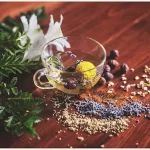Kratom is an herb that is prepared from the leaves of a tropical tree, Mitragyna speciosa. It has been used for generations both socially and to take advantage of unique properties like potential mood-boosting and energizing effects. It is part of traditional medicine in some parts of the world, and many use kratom daily for temporary relief of minor aches and pains. This article discusses the potential therapeutic effects of the active ingredients in kratom and how they may support good health and quality of life.
Table of Contents
Kratom Alkaloids And Research
The active components of kratom include complex chemical compounds known as alkaloids. There are more than 40 known alkaloids in kratom, and many are under study in universities and research labs across the United States, Europe, and other parts of the world.
While much research remains to be done, a great deal has been learned about kratom alkaloids. Studies indicate that many alkaloids found in kratom and other plants can affect human metabolism through interaction with the Central Nervous System, or CNS.
Alkaloids, The Brain, And The CNS
The brain, together with the CNS, monitors and controls almost every system in the human body. Some alkaloids may interact with receptors in the brain in the same way as neurotransmitters or hormones and produce similar effects. These compounds may be found in some fungi, animals, and many plants.
Plant Alkaloids
Researchers have identified many different alkaloid-producing plants, and the products made from them have had a tremendous impact on society. These plants are found in many parts of the world and include some of the following.
Cinchona (many species) – These plants can be used to produce quinine, an alkaloid that is a member of the Quinoline family of alkaloids. Quinine has been used to treat malaria since it was discovered in the 17th century by accident as an extract that could be produced by soaking roots and bark from certain trees in water. This important medicine is now manufactured by using a chemical process that yields isolated quinine.
Coffea arabica, Camellia sinensis, Cola nitida, Theobroma cacao, and more – These plants are used for many products, including coffee, tea, kola, and chocolate. These goods share one special component, caffeine, a bitter-tasting alkaloid with energizing and diuretic effects. This alkaloid is a member of the Purine family of plant alkaloids and can be found in thousands of different products.
Papaver somniferum, Corydalis (many species) – These plants produce alkaloids in the Isoquinoline family. They are primarily herbaceous flowering plants, such as the opium poppy, that produce complex phytochemical compounds in different stages of life. These alkaloids provide the base for many powerful painkillers.
Mitragyna speciosa, Hypericum perforatum, and more – These plants produce indole and indole-based alkaloids. Indole alkaloids are a major group of plant alkaloids that include more than 4000 examples like serotonin, physostigmine, and tryptamine. Serotonin has been shown to have mood-boosting qualities.
Indole-Based Alkaloids Unique To Kratom
The alkaloids mitragynine and 7-hydroxymitragynine make up the highest percentage of indole-based alkaloids in kratom, but there are dozens more. Each one is important to the overall effect. The concentration of each alkaloid depends on many factors, including the age of the leaf.
As an evergreen, Mitragyna speciosa does not drop its leaves every year and a typical tree may be covered with leaves in many different stages of development. Some leaves will be young, some will be old, and some will be in stages in between. Depending on their age, these leaves can produce different kinds of kratom, or strains. Generally speaking, young leaves are used to produce white kratom, adult leaves make green kratom, and older leaves may be reserved for red kratom. Other strains are possible, depending on the tree and the environment, but are less common in the consumer market.
Each strain of kratom has a different blend of indole-based alkaloids so each strain has a slightly different range of effects.
Therapeutic Effects of Kratom Alkaloids
Kratom alkaloids generally have predictable effects, but the strength and duration of the effects may vary depending on many factors, including the strain (white, green, red, etc.) and personal metabolism. This means that the same strain and amount of kratom, when used by different people, may produce different results.
The most common effects of kratom alkaloids include the following.
Energizing Effects
Kratom may have potential use as an energy-boosting supplement. A small amount of kratom may produce this effect, which is similar to the action of caffeine. Like caffeine, larger amounts of kratom may nullify this effect or work in reverse.
White kratom is often regarded as the most energizing strain but regional variations exist.
Immune System Boosting
Alkaloids like isopteropodine, which is found in small concentrations in kratom leaves, may help support the immune system. Research has shown this alkaloid exhibits some antimicrobial properties and may inhibit the growth of gram-positive bacteria. By reducing the workload on the immune system the body is free to spend energy on other metabolic processes.
Mood Elevating Properties
Some strains of kratom may elevate the mood in a variety of ways. This benefit may come from alkaloids that interact with serotonin receptors and the brain’s communication with the hippocampus, which controls emotional responses, memories, and more. This may be called a euphoric effect, and white kratom may have a higher potential for this effect than other strains, but some green and red strains may be euphoric for some users.
Calming Properties
The potential calming effects of kratom may stem from the activity of a variety of alkaloids, including mitragynine and 7-hydroxymitragynine. These alkaloids may interact with certain receptors in the brain that may promote feelings of tranquility and peace. Among the types of kratom most noted for this effect are red strains from Borneo, Sumatra, and Bali.
Temporary Relief From Minor Discomfort
Mitragynine and 7-hydroxymitragynine may provide temporary relief from minor aches and pains. Studies into this effect are ongoing and seem to indicate that these alkaloids may interact with certain receptors in the brain that affect the pain response.

Consumer Notes
If you are curious about kratom and want to try it, there are some terms used by suppliers that you should know. For example, some manufacturers use the word “vein,” as in white vein or green vein kratom. These strains are the same as white kratom, green kratom, etc. The addition of the word “vein” (or “strain”) on a label is entirely optional.
Maeng Da kratom, in general, means highly concentrated or extra strong. The name comes from a slang phrase that originated in Thailand.
If you’re shopping to buy kratom online, it’s important to read the product’s potential effects and this includes customer reviews.
A Natural Herbal Powerhouse
Kratom has many potential benefits. If you’re thinking about trying this unique ethnobotanical, make sure to find a manufacturer that offers a variety of high-quality products made from sustainably harvested leaves. This helps the ecology and the local economy of neighborhoods with farms that produce kratom products. It also helps to fight the elimination of unique microclimates, allowing you to tap into the healing power of nature while supporting a balanced and environmentally harmonious lifestyle.








